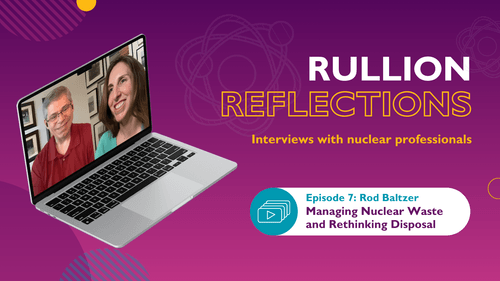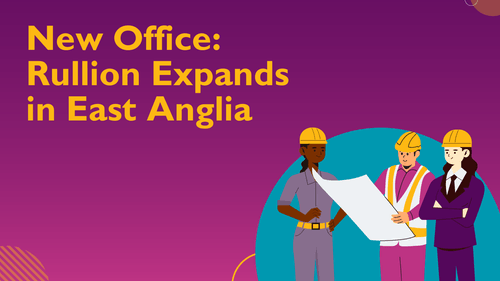Managing Nuclear Waste and Rethinking Disposal with Rod Baltzer
An unintended journey into nuclear waste
Rod Baltzer didn’t plan a career in nuclear. His professional journey began in accountancy, far from reactors and nuclear energy waste repositories.
“I’m actually a CPA, an accountant… and the company I joined owned a radioactive waste business. I got involved through finance and have been fascinated with the industry for the last 25 years.”
As Rod became more involved in the waste side of the business, he found himself increasingly drawn to the technical and regulatory complexities of the nuclear sector. It was an industry unlike any other he had encountered.
Over time, that “accidental” entry point evolved into deep expertise. Before joining Deep Isolation, Rod served as President and CEO of Waste Control Specialists (WCS), where he oversaw operations, regulatory engagement, and the NRC licence application for the consolidated interim storage of used nuclear fuel. This experience has since positioned him as one of the industry’s leading voices on nuclear waste management and a strong advocate for innovation at the back end of the fuel cycle.
His story is a powerful reminder that the future of nuclear isn’t shaped only by those who start there, but by those curious enough to step into it.The biggest misconceptions about nuclear waste
When people hear “nuclear waste”, their minds often go to green goo, danger, or sci-fi-style mutations. In reality, it’s something far more controlled and far more common than most realise.
“You think of The Simpsons and the green goo, but it’s just not that way… Most people don’t realise they probably live within about 50 miles of nuclear waste... There is so much misperception about safety, but we have such a long track record of doing things safely.”
What many don’t realise is how limited the truly high-level waste stream is in the UK. In the UK, less than 10% of radioactive waste by volume is planned for deep geological disposal. The vast majority is low-level waste that can be safely managed through existing, tightly regulated facilities. The Office for Nuclear Regulation and Environment Agency reported future disposal sites for higher activity waste will be governed by “rigorous safety, security, safeguards and environmental standards throughout all phases”.
This gap between perception and reality is one of the biggest barriers facing the future of nuclear, and it directly impacts policy, funding, community acceptance, and talent attraction.
Rethinking nuclear waste storage
For decades, the accepted solution for storing spent nuclear fuel has been a deep, mined repository. Massive 18-foot-wide mine repository tunnels with complex ventilation systems and huge infrastructure costs.
But Rod and the team at Deep Isolation have taken a radically different approach to managing nuclear waste, borrowing proven technology from the oil and gas sector. Instead of enormous underground chambers, Deep Isolation uses slim boreholes just 21 inches wide, drilled deeper and laterally, significantly reducing cost and surface disruption (2-3% of the traditional site). This approach could result in faster deployment timelines using drilling rigs rather than multi-year tunnelling projects.
“Without all the engineered barriers and ventilation systems, we’re at less than half the cost of a mined repository.”
The power of transferable talent
Over the last few years, the nuclear industry has been actively recruiting from beyond its traditional pipeline. In the UK, the civil nuclear workforce grew by 35% between 2021 and 2024, reaching approximately 87,000 workers. For many roles, the key isn’t a nuclear-specific degree but rather experience in heavy industry, drilling, robotics or remote operations. All skills that transfer from sectors such as oil & gas, mining and construction.
One of the most compelling parts of Rod’s story is the new talent pipelines Deep Isolation unlocks. Oil and gas professionals, drillers, geologists, robotics engineers and remote-ops operators are now nuclear-eligible talent.
“We feel like we could repurpose oil and gas drilling rigs… instead of extracting valuable resources, we’re putting spent fuel underground.”
Rod explains that the same drilling rigs and competencies used in oil and gas can be repurposed for nuclear waste disposal, shifting their purpose from extraction to containment. This opens the door for people with transferable skills from other sectors, giving them a pathway to retrain into the nuclear industry.
How can we attract the next generation of nuclear talent?
At a time when the nuclear industry is facing a global ‘skills gap’, Rod believes one of the biggest missed opportunities is simply access. Many students study nuclear engineering, physics, or related disciplines without ever seeing what those careers actually look like in practice.
One of the most hopeful moments in the conversation comes when Rod describes welcoming students to Deep Isolation’s demo centre. For many of them, it was their first real exposure to the physical infrastructure and technology behind nuclear power waste management.
“They got to see an oil and gas rig and our canisters… and they came away very excited. They said, ‘We’d never really seen this before. It kind of opened us up to this new field.’”
In an industry projected to require tens of thousands of new skilled workers over the next two decades, Rod believes this kind of early, hands-on exposure must move from “nice to have” to a strategic priority. Because you can’t build the future of nuclear if the next generation never gets to see it.
A career path people don’t realise exists
There are thousands of roles within the nuclear ecosystem that people simply don’t realise are open to them.
Perhaps the most encouraging part of Rod’s story is just how many different routes there are into the nuclear sector, including for those who never expected to end up there. He didn’t begin as a nuclear engineer or geologist; he began as an accountant. Over time, curiosity and exposure drew him deeper into the complexities of nuclear waste, regulation, and long-term environmental responsibility, fundamentally reshaping the direction of his career.
His journey shows that nuclear is not a closed ecosystem reserved for a select few. It is supported by an entire network of disciplines, including finance, project management, drilling, geotechnical engineering, data analysis, operations, and risk modelling. In many cases, it is the combination of these perspectives that drives the most meaningful innovation.
The future of nuclear waste
The future of nuclear isn’t just about new reactors or flashy technology. It’s about legacy and intelligent design. Rod’s vision is a shift from reactive to proactive thinking:
Integrating waste planning into early reactor design
Reducing misperceptions through transparency
Opening pathways for cross-sector talent
Making nuclear simpler, not scarier
In many ways, how the industry goes about managing nuclear waste will define how the world chooses to trust nuclear at scale. Because building trust in nuclear means investing just as much in safe, transparent waste solutions as we do in the next generation of people who will deliver them.
Watch the full interview.
If you’d like to explore more perspectives from Deep Isolation’s leadership, you can also revisit our earlier conversation with cofounder Liz Muller, whose vision helped lay the foundations for the borehole disposal approach. Read and watch the full interview: “Rethinking Nuclear Waste: Liz Muller’s Mission to Revolutionise the Industry.”




























































